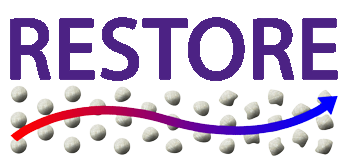Smouldering (STAR) for Soil Remediation and Site Restoration
Background
Organic industrial liquids (e.g., chlorinated solvents, coal tars, creosotes, and petroleum hydrocarbons) are among the most common, persistent, and difficult to remediate contaminants. Typically present as non-aqueous phase liquids (NAPLs), they are able to contaminate very large volumes of soil and groundwater above the health-based environmental standards. In addition, due to their resistance to degradation, these NAPLs are expected to pose environmental liability for decades to centuries. And practical solutions remain elusive. One category of NAPL contamination that has received much less attention is petroleum hydrocarbons. One source is oily sludge: the three to five percent of all crude oil produced that is ultimately unusable, and which is routinely collected in oil production and refinery operations. This represents a problem of significant proportions with no acceptable solution. Worldwide oil sludge production rates are unknown; China alone produces more than 1×109 m3 annually. Oil sludge exhibits total petroleum hydrocarbon (TPH) concentrations on the order of 250,000 mg/kg - two orders of magnitude higher than typical regulatory limits and thus represents hazardous waste. A second source is oil that enters the environment via tanker/pipeline ruptures and off-shore drilling accidents, much of which ends up in beach and marine sediments. Smouldering (STAR) is a highly promising remediation solution for both in situ (on site) and ex situ (excavated soils, lagooned sludges) environmental challenges.

Comparison of oil-contaminated soil before and after smouldering (STAR) treatment in a field pilot test in Taiwan (Gerhard et al., 2020).
Program Objectives
This research aims to advance STAR as an effective, economic, energy efficient and sustainable soil and sludge remediation technology. Specific project objectives include:
- Develop novel understanding of the science underpinning STAR for remediation
- Discover new applications of STAR and scale-up the technology to support engineering implementation; and
- Optimize the performance of STAR remediation strategies for both in situ and ex situ applications.
Research Methods
Laboratory Investigations
Experiments in the world-leading STAR labs are underway to achieve the program objectives. Experiments are investigating the kinetics of smouldering reactions, quantifying contaminant destruction, exploring the impact of in situ heterogeneity on STAR, and quantifying means of optimizing the process.


STAR laboratory investigations into soil contaminant destruction and methods for site remediation
Click here for more project photos
Pilot Field Applications
Western researchers collaborate with our industrial partners at Savron to conduct pilot tests of new STAR applications. These are critical for bridging the gap between laboratory experiments and full scale commercial applications. Western has helped develop numerous new applications for STAR and methods for implementation through this longstanding and excellent collaboration.

Figure 12. Photographs of STAR pilot and large scale ex situ treatment systems developed and tested in collaboration with Savron, leading to commercial applications aronud the world (Gerhard et al., 2020).
Numerical modeling
Numerical models being developed in-house simulate the propagation of the STAR in complex scenarios including heterogeneous subsurface environments and ex situ treatment systems for sludge. These models provide unique insights into how to design and optimize the remediation applications.


Multiphase modelling of smouldering front propagation
in response to airflow distribution in an ex situ STAR treatment pile.
Program Output
Journal Papers (2014 - 2020)
Torero, J.L., J.I. Gerhard, M.F. Martins, M.A.B. Zanoni, T. Rashwan, J. Brown, 2020. Processes Defining Smouldering Combustion: Integrated Review and Synthesis. Progress in Energy and Combustion Science, 81 (100869): 1-43, DOI: 10.1016/j.pecs.2020.100869.
J.I Gerhard, G. P. Grant, and J.L. Torero, 2020. STAR: A Uniquely Sustainable In Situ and Ex Situ Remediation Process. In Sustainable Remediation of Contaminated Soil and Groundwater: Materials, Processes, and Assessment. Deyi Hou Ed., Elsevier Textbooks. ISBN: 9780128179833.
L. Torero, J. I. Gerhard, L. L. Kinsman, L. Yermán, 2018. Chapter 12: Soil remediation by underground fires. In Underground Coal Gasification and Combustion, M.S. Blinderman and A. Y. Klimenko Editors, Woodhead Publishing Series in Energy, godhead Publishing. ISBN: 978-08-100313-8.
Gerhard, J.I. 2016. Smouldering Remediation. Online Textbook “Remediapedia”. Authored exclusively by invited experts, peer-reviewed and supported by US Government SERDP and ESTCP programs. Available at: http://www.environmentalrestoration.wiki/index.php?title=Smoldering_Remediation
Solinger, R., G. Grant, G. Scholes, C. Murray, J.I. Gerhard. 2020. STARx Hottpad for Smouldering Treatment of Waste Oil Sludge: Proof of Concept and Sensitivity to Key Design Parameters. Waste Management & Research. 38(5): 554-566. DOI: 10.1177/0734242X20904430
Zanoni, M.A.B., J.L.Torero, and J.I.Gerhard, 2019. Delineating and explaining the limits of self-sustained smouldering combustion, Combustion and Flame, 201: 78-92. DOI: 10.1016/j.combustflame.2018.12.004.
Zanoni, M.A.B., J.L.Torero, and J.I.Gerhard, 2018. Determining the conditions that lead to self-sustained smouldering combustion by means of numerical modelling, Proceedings of The Combustion Institute, DOI: 10.1016/j.proci.2018.07.108
Zanoni, M.A.B., J.L.Torero, and J.I.Gerhard, 2018. The Role of Local Thermal Non-Equilibrium in Modelling Smouldering Combustion of Organic Liquids, Proceedings of The Combustion Institute, DOI: 10.1016/j.proci.2018.05.177
Zanoni, M.A.B., J.L.Torero, and J.I.Gerhard, 2017. Determination of the interfacial heat transfer coefficient between forced air and sand at Reynold’s numbers relevant to smouldering combustion. International Journal of Heat and Mass Transfer. 114, 90-104. DOI: 10.1016/j.ijheatmasstransfer.2017.06.020.
Ebrahimzadeh, M., P. Tsourlos, J.I. Gerhard, 2017. Self-potential for monitoring soil remediation by smoldering: proof of concept. Near Surface Geophysics, 15, 484-494. doi: 10.3997/1873-0604.2017021.
Kinsman, L., J. I. Gerhard, and J. L. Torero. 2016. Smoldering remediation and non-aqueous phase liquid mobility. Journal of Hazardous Materials, 325, 101-112. doi: /10.1016/j.jhazmat.2016.11.049.
Scholes, G., JI. Gerhard, G.P. Grant, D.W. Major, J.E. Vidumsky. 2015. Smoldering remediation of coal tar contaminated soil: pilot field tests of STAR. Environmental Science and Technology, DOI 10.1021/acs.est.5b03177, 1 – 9.
Hasan, T. JI Gerhard, RM. Hadden, G. Rein. 2015. Self-sustaining smouldering combustion of coal tar for the remediation of contaminated sand: Two-Dimensional Experiments and Computational Simulations. Fuel, 150: 288-297.
Salman, M., J.I. Gerhard, D. W. Major, P. Pironi, and RM. Hadden, 2015. Remediation of trichloroethylene-contaminated soils by STAR technology using vegetable oil smoldering. Journal of Hazardous Materials, 285: 346 – 355. doi:10.1016/j.jhazmat.2014.11.042
Switzer, C., P. Pironi, JI Gerhard, G. Rein, and JL Torero, 2014. Volumetric scale-up of smouldering remediation of contaminated soils. Journal of Hazardous Materials, 268, pp. 51-60.
Project Team
Project Leaders:
with
Jose Torero (University College London)
Gavin Grant (Savron)
Project Members:
Joshua Brown, Research Engineer
Marco Zanoni, PDA (Completed 2020)
Jorge Gabayet, Research Engineer (Completed 2017)
Cody Murray MESc (Completed 2019)
Lais Trento MESc (Completed 2017)
Gavin Overbeeke, MESc (Completed 2016)
Rebecca Solinger, MESc (Completed 2016)
Laura Kinsman, MESc (Completed 2015)
Mehrnoosh Ebrahimzadeh, MESc (Completed 2015)
Melissa Hardy, UG Intern (Completed 2019)
Kia Barrow, UG Thesis (Completed 2019)
Meghan Green, UG Intern (Completed 2019)
Anna Toner, UG Intern (Completed 2019)
Jad Choujaa, UG Thesis (Completed 2020)
Supporting Organizations:








